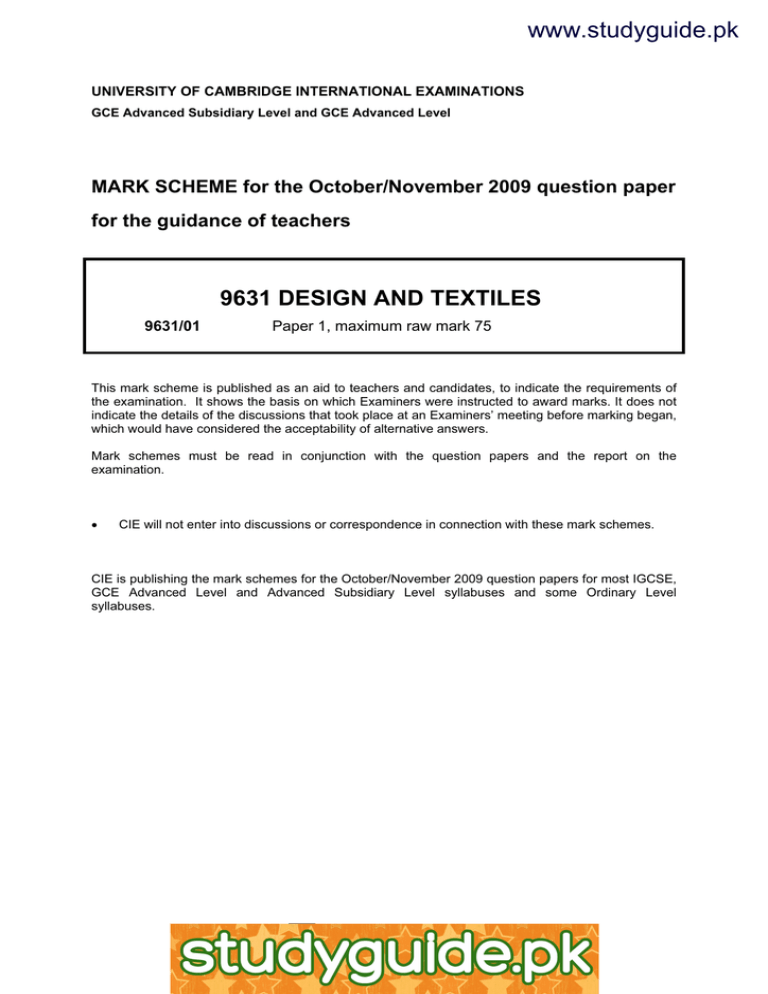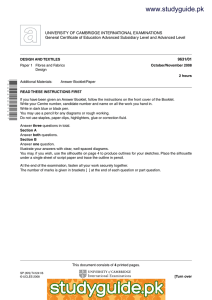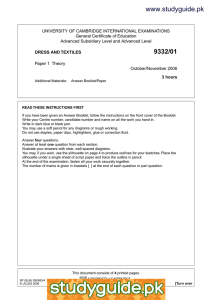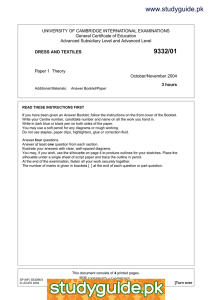www.studyguide.pk 9631 DESIGN AND TEXTILES
advertisement

www.studyguide.pk UNIVERSITY OF CAMBRIDGE INTERNATIONAL EXAMINATIONS GCE Advanced Subsidiary Level and GCE Advanced Level MARK SCHEME for the October/November 2009 question paper for the guidance of teachers 9631 DESIGN AND TEXTILES 9631/01 Paper 1, maximum raw mark 75 This mark scheme is published as an aid to teachers and candidates, to indicate the requirements of the examination. It shows the basis on which Examiners were instructed to award marks. It does not indicate the details of the discussions that took place at an Examiners’ meeting before marking began, which would have considered the acceptability of alternative answers. Mark schemes must be read in conjunction with the question papers and the report on the examination. • CIE will not enter into discussions or correspondence in connection with these mark schemes. CIE is publishing the mark schemes for the October/November 2009 question papers for most IGCSE, GCE Advanced Level and Advanced Subsidiary Level syllabuses and some Ordinary Level syllabuses. www.xtremepapers.net www.studyguide.pk Page 2 Mark Scheme: Teachers’ version GCE A/AS LEVEL – October/November 2009 Syllabus 9631 Paper 01 SECTION A Answer both questions. 1 Weaving is widely used to construct fabrics. (a) Explain the basic structure of a plain woven fabric. Answer could include: warp threads, which are set up on a loom first before any weaving takes place; weft threads are then interlaced at right angles to the warp threads, in a simple over one, under one pattern, to form a firm structure; the weft thread is usually continuous although it could be pre-cut if the rapier or jet looms are used; well labelled diagrams could be included; a selvedge is formed at the edge of the fabric, where the weft threads meet the edge and continue back for the next row; the selvedge could be a looped edge or a short fringe, depending on the type of loom used; the true cross is the position on the fabric which runs diagonally across the fabric and is the stretchiest part; bias is any other position on the fabric which is not the warp, weft or true cross, it is also stretchy but not as stretchy as true cross. 1 mark for each well explained point. [4] (b) Using sectional diagrams, compare the structure of: (i) a named woven jacquard fabric Answer could include: named jacquard fabric could be viscose tapestry; linen damask, or any other suitable name; diagram showing warp threads clearly; could be side view showing position of threads or side view and surface view, showing thread positions/and/or squared representation of warp/weft threads; weft threads form the jacquard design and is made up of different weaves, such as plain, twill and satin; large floral patterns are often woven into the fabric; card system or computer system used to raise and lower individual warp threads to form the design on the fabric; colour can be introduced in warp/weft threads to form patterns; lace effect jacquard if different designs shown. (ii) a named woven pile fabric. Answer could include: named pile fabric could be cotton velvet; silk velvet; viscose crushed velvet; or any other suitable name; warp threads set up on the loom, similar to jacquard fabric; weft threads are raised and lowered together, usually alternate threads for plain weave; no specific pattern on fabric due to weaving; pattern could be introduced by using different coloured warp/weft threads to form stripes/checks; could be computer controlled; extra set threads for pile. Any other appropriate point. Answers must be well explained, using sectional or other appropriate diagrams. 1 mark for each well explained point. © UCLES 2009 www.xtremepapers.net [6] www.studyguide.pk Page 3 Mark Scheme: Teachers’ version GCE A/AS LEVEL – October/November 2009 Syllabus 9631 Paper 01 (c) Assess the performance characteristics of both fabrics named in (b). Answer could include: named fabric needs to be specified, and answer will relate to the fibre content of the fabrics e.g. cotton damask and viscose crushed velvet. e.g. cotton damask is a medium weight fabric which creases readily and will need ironing after washing; it is absorbent and is often used for table coverings; it is often one colour only, white being popular, and floral design can be seen on the surface, which are made up of different weaves, which forms the pattern. Viscose tapestry fabric is often thicker than cotton and is made up of a variety of colours, in both the warp and weft, (unlike cotton damask) which forms a complicated figured design on the surface; the fabric is often used for curtains or as an upholstery/cushion cover fabric due to being thicker and heavier than cotton damask; e.g. viscose velvet fabric is heavy weight, has good draping qualities; ironing not needed because of the nature of the crushed finish, however, can be steamed; fabric is thick and covers well; fabric can be used for curtains, as well as clothing for evening wear, both due to desirable drape. performance characteristics such as: drape; absorbency; elasticity; warmth; feel/handle; comfort against durability/hardwearing qualities; effect of laundering; effect of fabric finishes. Any other appropriate points. 1 mark for each well explained point. the skin; [8] (d) Discuss how the performance characteristics of a knitted pile fabric differ from a woven pile fabric. Answer could include: knitted fabrics are very floppy and drape well; they are usually stretchy if weft knitted, which is the usual method for knitted pile fabrics; uses include: jumpers, sportswear, blankets; both woven and knitted pile fabrics trap air and are warm which make them suitable for clothing/household items where insulation is required; woven pile fabrics are medium to heavy weight and knitted pile fabrics are bulky without so much weight; woven fabrics are firm and non stretchy; knitted fabrics often have the pile surface on the wrong side of the knitting; woven pile fabrics usually have the pile on the right side; both fabrics are very absorbent, and can be hard to wash, as once they absorb water, they become very heavy and knitted pile fabrics in particular, can stretch out of shape; dry cleaning could be recommended; knitted pile fabrics can stretch out of shape during wear and are often not long lasting fabrics; woven pile fabrics can last longer due to the dense nature of the weave. Any other relevant performance characteristic, well discussed. 1 mark for each well explained point. [7] [Total: 25] © UCLES 2009 www.xtremepapers.net www.studyguide.pk Page 4 2 Mark Scheme: Teachers’ version GCE A/AS LEVEL – October/November 2009 Syllabus 9631 Paper 01 There is a wide range of fibres available for the manufacturer of textiles. (a) State the sources of the following fibres: (i) viscose cellulose (wood pulp) and sodium hydroxide (caustic soda)/chemicals (ii) triacetate cellulose (cotton linters) and acetic acid/chemicals (iii) polyester ethylene glycol and terephthalic acid/chemicals only (iv) modacrylic. acrylonitrile (85%) and other additives/chemicals 1 mark for each point. Give some credit for ‘chemicals’ but not full marks. [4] (b) Describe the results you would expect to find when using the following tests on each of the fibres (i) – (iv) listed in (a). (i) microscope test Answer could include: (i) viscose: cross section (c.s.): irregular, although it can depend on the process used in manufacture, in which case it may be flatter or doughnut-like; longitudinal section (l.s.) has fine lines along length. (ii) triacetate: cs: less irregular than viscose, multi-lobal appearance with indentations; l.s.: occasional markings and fine lines along length of fibres. (iii) polyester: c.s: round; l.s.: smooth and straight. (iv) modacrylic: there are different appearances due to different methods of manufacture; c.s can be dog-bone shaped or round; l.s. straight and smooth. Accept labelled sketches. 1 mark for each fibre. [4] (ii) standard burning test. Answer could include: (i) viscose: burns quickly, yellow flame, smells like burning paper, light grey ash; (ii) triacetate: fuses away from flame, flames quickly, melts and drips; smells like vinegar; brittle ash; (iii) polyester: fuses away from flame, burns slowly with melting, sweet smell, leaves hard round black bead; (iv) modacrylic: fuses and shrinks away from flame, burns very slowly with melting, selfextinguishing, sharp, acrid smell, brittle black ash. 1 mark for each well described point. © UCLES 2009 www.xtremepapers.net [4] www.studyguide.pk Page 5 Mark Scheme: Teachers’ version GCE A/AS LEVEL – October/November 2009 Syllabus 9631 Paper 01 (c) Discuss the importance of the test results in (b) in relation to the performance characteristics of each fibre (i) – (iv) listed in (a). Answer could include: (i) viscose: hollow cross section/striations: good absorbency and ease of washing; low lustre due to striations; flammable, and may need fire resistant finish; (ii) triacetate: shiny fabric due to smooth surface; stains less as dirt brushes off easily; solid fibre so not very absorbent and ease of washing and drip dry; flammable, so will need flame resistant finish; (iii) polyester: very smooth surface, shiny fabric, non absorbent, easy to wash and dries quickly; melts and drips, so if used for nightwear, will need a flame resistant finish; (iv) modacrylic: striations along surface (e.g. dogbone shape) will allow some absorbency; smooth surface will mean shine on surface of fibres; iron temperatures; permanent pleats; can assess if fabric is a blend/mixture; non flammability will mean it is cost effective when using for home furnishings. 1 mark for each well explained point. [8] (d) Assess the reasons for using elastane fibres, as part of a fibre blend, for fashion clothing. Answer could include: elastane: elastomeric, Spandex, stretches 4 to 7 times its original length; often used as a blend for figure hugging clothing e.g. tops, swimwear, sportswear, hosiery etc; only very small percentage of elastomeric fibres needed due to its high elasticity, e.g. 2% – 5% when used with fibres such as cotton or viscose; comfortable to wear; absorbent; blends well with most fibres; can also be produced as ‘core spun’ yarns so comfortable and can take on the handle and appearance of the fibre it has around the core; easy to wash, quick drying; reduces use of fastenings; all sizes of body, comfort; smooth, sleek look. Any other appropriate point. 1 mark for each well explained point. [5] [Total: 25] © UCLES 2009 www.xtremepapers.net www.studyguide.pk Page 6 Mark Scheme: Teachers’ version GCE A/AS LEVEL – October/November 2009 Syllabus 9631 Paper 01 SECTION B Answer one question. 3 Texture and colour are important factors to consider in designing. (a) Explain what is meant by ‘texture’ in relation to textile items. Answer could include: texture: the feel, handle, appearance of yarns or fabrics; the surface may be bobbly, smooth, hairy, etc, examples of different yarns/fabrics; e.g. boucle yarn, cotton velvet fabric, etc additional items/accessories can be added to the surface e.g. beading, sequins or other decorative pieces can be sewn on. 1 mark each for two well explained points. [2] (b) Assess the way in which ‘texture’ can be used to enhance the appearance of items made for the home. Answer could include: yarns can be used to add surface decoration (e.g. shiny silk yarn could be used for making trimmings such as tassels); yarns can be sewn on by hand or machine as surface decoration/embroidery; fabrics can be used as applique, e.g. wool boucle or cotton velvet have raised surfaces and would contrast well with a cushion cover which had a smooth background surface; quilting can be used to make a smooth fabric more interesting or to add decoration due to the stitching used in quilting; textile techniques can be used to produce texture, e.g. several layers of fabric can be stitched together then the surface can be cut to produce fraying and a textured surface; any other textile techniques which have been well explained. 1 mark for each well explained point. [5] (c) Discuss the way in which designs for textile items can be developed, using ideas from natural sources. (You may use labelled diagrams in your answer.) Answer could include: designs can be one-off or repeated; natural sources can include any plants, animals, shells, insects, etc. the designs from them can be developed from detailed recording of colour patterns e.g. the wings of a butterfly has many spots which will have a range of colours and can be stitched in various textured threads; these colours can be used in the design and the scale of the spots can be enlarged; a variety of scales can be used e.g. large spots and small spots together on a repeated design which could be interpreted in different textured fabrics; flower designs can be used to produce detailed flower centres which could later be printed onto fabric; texture could be added to enhance the design work; drawings from tree bark could be used to produce textured fabrics and embroideries e.g. the centre panel of cushion covers could have a textured detail using smocking with a plain border design; colour schemes can be used as inspiration for dye work – e.g. shades of blue from the study of water, could be used to produce tie and dye work, where blue dye is used and varying shades of blue are obtained depending on the method of tying used; this could be used to dye a variety of different thicknesses of fabrics, which could be made into flowers and stitched on as 3D flowers; © UCLES 2009 www.xtremepapers.net www.studyguide.pk Page 7 Mark Scheme: Teachers’ version GCE A/AS LEVEL – October/November 2009 Syllabus 9631 Paper 01 fruits and vegetables cut in half produce interesting patterns e.g. lemons, tomatoes, peppers, kiwi fruit etc can be used as inspiration for interesting design work; the designs can be simplified to produce lino cuts or potato printing can be developed from the designs; these shapes could then be embroidered with French knots and stem stitch; animals eyes are varied and can be used to draw from – they can be simplified to produce interesting repeated designs; colours can be changed e.g. a blue/black/red eye can be changed to green/pink and orange; this can then be stitched using embroidery stitching such as seeding; printing can be combined with surface decoration so that a design and texture can be used in combination; natural fibres e.g. cotton, flax, silk, wool; natural dyes e.g. indigo. Give credit for labelled diagrams. Any other relevant point. 1 mark for each well explained point. [9] (d) Assess the importance of colour in textiles and how a ‘mood’ or ‘message’ can change when different colours are used. Answer could include: colour wheel: primary (red, yellow and blue); secondary (orange, green and purple); colour associations with specific colours, e.g. red: anger, danger, want to be noticed; blue: calming, water, relaxing, stress-free; yellow: bright, spring, happy; black; darkness, grief, sadness; some colours absorb light e.g. blue, violet, are cold; colours which reflect light e.g. red, yellow, orange, are warm; black and white represent positive and negative and are often used as ‘neutrals’ in fashion clothing; colours associated with different cultures, e.g. red or purple associated with royalty; black in Chinese colour signifies winter; blue: heaven eternity; brown: the earth; yellow/gold: the sun; clothing in specific colours used for work e.g. black or blue to look important/formal for work wear/office wear; clothing worn for specific ceremonial occasions e.g. weddings, festivals etc. Any other appropriate point, well-discussed. Give credit for labelled diagrams. 1 mark for each well-explained point. [9] [Total: 25] © UCLES 2009 www.xtremepapers.net www.studyguide.pk Page 8 Mark Scheme: Teachers’ version GCE A/AS LEVEL – October/November 2009 Syllabus 9631 Paper 01 OR 4 Paper pattern production can be carried out at home or in industry. (a) Explain what is meant by the following in relation to paper patterns. (i) grading Answer could include: pattern grading is a way to produce a range of standard sizes when manufacturing clothing; often sizes range from size 6 (or less) to size 18 (or more); sizing depends on the age range the clothing is targeted at, e.g. ‘young fashions’ may only be graded for a limited number of sizes such as size 6 to size 14; not every part of the pattern piece is graded e.g. necklines and side seams may be graded but armholes may not be; patterns for home use are often also bought as multi-size, where the consumer chooses which size to cut out; computer package e.g. CAD. Any other appropriate point. Give credit for labelled diagrams. 1 mark for each well explained point. [2] (ii) lay planning lay planning is the way the pattern pieces are arranged on the fabric to give the most economical layout; when produced in bulk, in industry, the layout is usually done by computer, so that the most economical layout can be done; this saves money and reduces waste; several different sizes may be cut out together; several items using the same fabric, can be included on the layout, to save wastage. Any other appropriate point. Give credit for labelled diagrams. 1 mark for each well explained point. [2] (b) State the importance of using ‘basic block’ patterns in industry. Answer could include: basic block used as starting point for pattern making, includes skirt, bodice, sleeve, trousers, etc; basic block is made in standard sizes e.g. size 12, 14 etc, so items will be standard sizes when made up; alterations can be made on just one part of the bodice/skirt/trousers/or whole garment can be altered; alterations can be saved and re-used or adapted for a future design; basic block patterns are usually made from card so are durable and can be re-used; large numbers of garments made; CAD: accuracy. Any other appropriate point. Give credit for labelled diagrams. 1 mark for each well explained point. © UCLES 2009 www.xtremepapers.net [4] www.studyguide.pk Page 9 Mark Scheme: Teachers’ version GCE A/AS LEVEL – October/November 2009 Syllabus 9631 Paper 01 (c) Discuss the ways in which a commercial skirt pattern could be adapted to produce new styles. Answer could include: basic block shape can be used to show: dart manipulation, to give shaping to waist or hip area; pleats and tucks could be added at waist or hem to give ‘balloon’ effect skirt hem; fastenings added e.g. button/buttonhole band to waist front or back; skirt shape could be altered to make a very wide hem, such as a circular or semi-circular skirt; yoke shape could be added by cutting basic block and adding a join between yoke and rest of skirt; gored panels can be added to make a 4, 6 or 8 panelled skirt; insets/godets could be introduced into seams to give more shape to skirt hem; whole skirt could be changed to be cut out on bias of fabric so it changes the ‘hang’ of the skirt, this may incorporate gores e.g. 4 gored skirt with panels cut on bias; CAD package used. Any other appropriate point. Give credit for labelled diagrams. 1 mark for each well explained point. [8] (d) Assess the choice of different garment edge finishes available to the garment maker. Answer could include: hems: plain, top-stitched, false using binding, fringed, etc; sleeve ends, e.g. cuffs, lace trim, gathered into a band, plain hem, shirt style, etc; neckline edges e.g. facings, collars, shaped neckline, bound, draw-string, etc; decorative finishes by machine: e.g. use of machine; embroidery/automatic patterns, scalloped edge using special edge stitch, scalloped edges, etc; decorative edges by hand: e.g. hand worked scallops, embroidery stitches along edge, e.g. stem stitch, chain stitch; addition of trimmings e.g. lace, braid, crochet etc; addition of different fabric e.g. different coloured binding; thinner see-through fabric; shiny/glittery fabric, etc; beads/sequinned/ribboned edges which have been pre-manufactured; these could be hand stitched or machined a plain hem; details of how the edge can be worked, including detailed labelled diagrams. Accept seam edge finishes. Any other appropriate point. 1 mark for each well explained point. [9] [Total: 25] © UCLES 2009 www.xtremepapers.net






